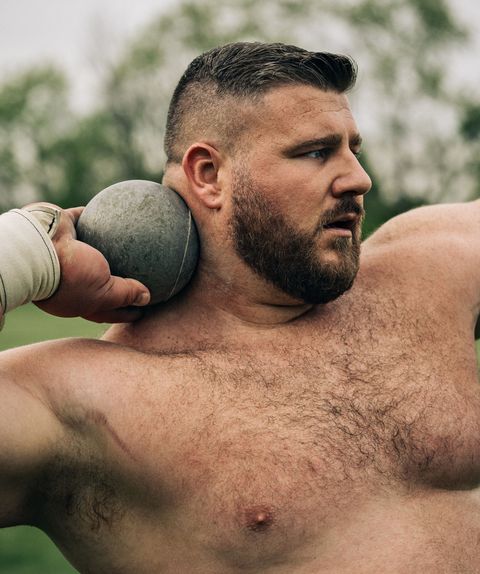
ON HIS INSTAGRAM feed, there is a picture of Joe Kovacs doing a full straddle jump into a swimming pool, touching both toes with the ease of a cheerleader. Except Kovacs is five-foot-eleven, 310 pounds, eats 12 eggs and two and a half cups of oatmeal for breakfast, and lives at the top of a sport typically known for big men with big power, not bulky ballerinas.
But Kovacs, 32, has used his focus on mobility and the idea that a 16-pound iron shot put goes a lot farther when you “whip it rather than push it” to build a collection of precious medals: gold at the 2015 and 2019 World Championships and silver at the 2016 Olympic Games and 2017 World Championships.
At that 2019 World Championships, in Doha, Qatar, Kovacs’s winning throw of 22.91 meters—just over 75 feet—was the third farthest in history and the farthest, by anyone of any nationality, in nearly three decades. “That meant so much to me,” he says. “As shot-putters, we are human cannons. The ball has to go far.” For Kovacs, the challenge has always been avoiding the dreaded foul, when the shot-putter touches or steps out of the seven-foot-wide circle during his throw. On his winning attempt, he whirled his body counterclockwise with aggression, landed on his right foot, and managed to diffuse all the energy he’d created, hopping without ever bouncing forward.

That unique control, coupled with Kovacs’s strength, makes him a shot-putting force. During lockdown, he spent quality time at the rack in his basement, pushing insane strength numbers with his wife and coach, Ashley Kovacs, a former thrower for the University of Kentucky and the throws coach at Ohio State University, as his spotter. He squatted 800 pounds for five reps and benched 650 pounds for five reps. He spends plenty of time unwinding that bulk, too. Kovacs warms up by running until he breaks a sweat, then focuses on hip, groin, and spinal stretches before ever touching a shot put. He uses yoga and gymnasticsto become more bendy. “I try to get as much length as I can, because torque and separation between the upper and lower body are the X factors in shot put,” he says. “Shot put is rotational and it requires very quick feet, and you have to be mobile to generate speed.”

During Kovacs’s training for the Tokyo Olympics, the Bethlehem, Pennsylvania, native beat every personal best with every implement (shot put, discus, and hammer) and every weight in the weight room. He has no doubt he can go to Japan and return with a medal. But this time, his goal is to top his 2016 performance in Rio and finish in first place. “If the ball doesn’t go over 74 feet, you’re not getting a medal this Olympics,” he says. “But I have lots of confidence right now.”
Kovacs’s tactics to boost strength, speed, and power:
Ignite Your Posterior Chain
“Everyone overlooks their posterior chain,” Kovacs says, referring to the muscles in your lower back, glutes, hamstrings, and calves, which work together to help you lift with power. He does lots of Romanian deadlifts, squats, and kettlebell swings, as well as reverse hyperextensions. Even Supermans—when you lie on your stomach and raise your arms and legs—can do the trick. “Anytime you squeeze the lower back, you’re building posterior power,” he says.
Bear Hug for Rotational Power
You may have tried a standing Russian twist with a plate, but Kovacs’s subtle, er, twist on the move trains rotational power, prepping your body to twist and lift a case of water off to the side with ease. Grab a heavier weight—a 55-pound kettlebell, sandbag, or plate—and hug it close to your body (hence the name “breathe-out bear hug”). Stand with your feet hip-width apart and facing forward, exhale, and rotate your trunk as far to the right as possible. Inhale, return to center, then repeat on the other side.
Focus on Effort, Not Numbers
Concentrating on max effort rather than his actual max has changed Kovacs’s mentality in the weight room. If your body is fatigued or you’re having a down day, you won’t be disappointed by lackluster rep numbers. “If you put in max effort or max speed, the numbers don’t matter,” he says. “But you have to be honest with yourself.”
Watch the Tokyo Olympics beginning July 23 and the Tokyo Paralympics , beginning August 24, on NBC. To learn the latest, visit TeamUSA.org
This story originally appeared in the July/August 2021 issue of Men’s Health.
Source: Read Full Article